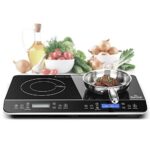What are food dehydrator functions?
Apple chips, dried mango, and beef jerky are just a few of the delicacies you can prepare with a food dehydrator…
…which dries foods at a low temperature for a long time.
The lack of moisture enhances the flavor of the food, making fruit sweeter and herbs more pungent…
…it also allows it to be stored for longer periods of time.
This is Elanora’s story.
My mother hated fruits, but I knew it was needed for her to consume fruits.
She doesn’t like vegetables too, so where can she get all the vitamins?
Then, my friend opened a small business that I and Mom really love.
She sold fruit and vegetable chips!
It was so good! No wonder Mom likes it a lot.
When I asked what she used to make them with, she told me she was using a dehydrator.
Since then, I’ve been saving up to buy one for myself!
Hopefully, my mom can get all the vitamins she needs in her crisp fruit bowl.
This is the secret!
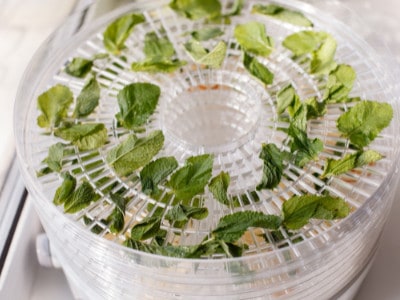
Homemade dehydrated food, in addition to being more flavorful and shelf-stable, are typically healthier than store-bought dehydrated snacks.
They typically contain just one whole ingredient that has been dried without any additives, preservatives, or calorie-dense ingredients like oil or sugar.
They can also be tailored to your specifications (you can add extra salt or none at all, for example).
Dehydrating food also maintains more nutrients than other cooking processes.
When kale, which is high in water-soluble and heat-sensitive vitamin C, is cooked, some of its immune-boosting properties are lost.
Its minerals and vitamins are better preserved by dehydrating it at a low temperature.
How Food Dehydrator Functions?
Dehydrators work by circulating air at a very low temperature to dry out foods.
To dry completely and evenly, the meals must be stacked in a single layer without touching.
Depending on the amount of water in the food, different temperatures are recommended:
Fruit and other water-dense items thrive from a higher temperature, such as 135°F, so they can dry fast without being too crisp.
Dehydrating vegetables at a lower temperature, such as 125°F, is possible.
To avoid over-drying and discoloration, delicate items like herbs should be dehydrated at a lower temperature, such as 95°F.
For meat, the USDA recommends cooking it first to an internal temperature of 165°F and then dehydrating between 130°F to 140°F.
This method is suggested to kill any potentially harmful bacteria and encourage the cooked meat to dehydrate quickly and safely.
Here’s what else you can do with your dehydrator:
- Dry homemade pasta
- Function as a yogurt maker that helps with fermentation.
- Make fruit leather, granola bars, dog treats, and more
- Make potpourri
- Recrisp stale foods like cookies or crackers.
- DIY art projects, like dehydrated flour and water molds that can be painted
The USDA suggests boiling beef to 165°F internal temperature before drying it between 130°F and 140°F.
This procedure is recommended for killing any potentially hazardous microorganisms and promoting rapid and safe dehydration of cooked meat.
What else?
- Handmade pasta, dry
- Yogurt fermentation
- Fruit rolls, granola bars, dog treats, and more may all be made using this recipe.
- Make your own potpourri
- Foods that have gone soggy, such as cookies or crackers, can be reheated.
- Dehydrated flour and water molds that may be painted are examples of DIY art projects.
Which Kind is the Best Dehydrator?
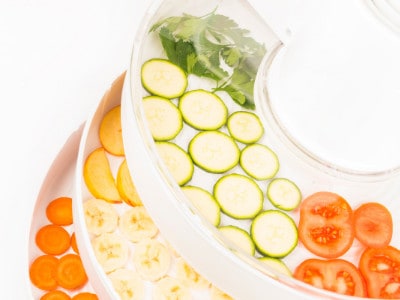
Dehydrators are divided into two types: those with stackable shelves and those with pull-out shelves.
The placement of the fan is the key variation between these two types, although we noticed little difference between them in our dehydrator tests when drying apple slices, parsley, and beef for jerky.
We also discovered that both designs provide models with a large temperature and timer range, which is a vital characteristic to look for if you want to be able to precisely regulate your results.
A modest fan on the base of dehydrators with stacked shelves circulates air upwards.
Stacking dehydrators are frequently less priced and take up less room.
Some are circular, while others are rectangular; we prefer rectangular ones since they have more surface area and can hold a wider range of ingredients.
Stacking dehydrators are great for inexperienced or infrequent dehydrator users.
A large fan at the back of dehydrators with pull-out shelves tends to circulate the air better and more evenly, resulting in more consistent outcomes.
To better manage the temperature, dehydrators with pull-out shelves are often composed of more solid materials.
For those who prefer not to cook on plastic, some include metal shelves instead of plastic.
Let Us Help You Shop!
COSORI Food Dehydrator
Prices pulled from the Amazon Product Advertising API on:
Product prices and availability are accurate as of the date/time indicated and are subject to change. Any price and availability information displayed on [relevant Amazon Site(s), as applicable] at the time of purchase will apply to the purchase of this product.
Magic Mill Food Dehydrator (7 Stainless Steel Trays)
Prices pulled from the Amazon Product Advertising API on:
Product prices and availability are accurate as of the date/time indicated and are subject to change. Any price and availability information displayed on [relevant Amazon Site(s), as applicable] at the time of purchase will apply to the purchase of this product.
Magic Mill Food Dehydrator (10 Stainless Steel Trays)
Prices pulled from the Amazon Product Advertising API on:
Product prices and availability are accurate as of the date/time indicated and are subject to change. Any price and availability information displayed on [relevant Amazon Site(s), as applicable] at the time of purchase will apply to the purchase of this product.
Food Dehydrator with Vertical Flow
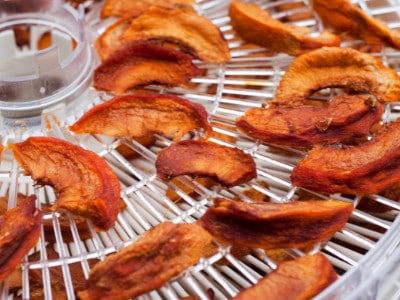
Food dehydrators with a vertical flow are also known as stacking food dehydrators. The heat source in these sorts of dehydrators is positioned at the top or bottom of the appliance.
They are made up of racks with trays for storing food throughout the preservation process. These food dehydrators are the most cost-effective solutions.
Despite the presence of a fan at the bottom of the device that propels the air upwards, the heat is not evenly distributed.
They work excellent for drying fruits and vegetables. Beef jerky, on the other hand, needs a little more effort.
During the cooking process, rotate the trays to ensure that all of the beef in each tray is evenly heated.
A stacking food dehydrator has racks that are stacked on top of one another and are sealed so that heat does not escape.
An electrically powered base distributes hot air to all of the shelves containing food that has to be dried.
Food Dehydrators with Horizontal Flow
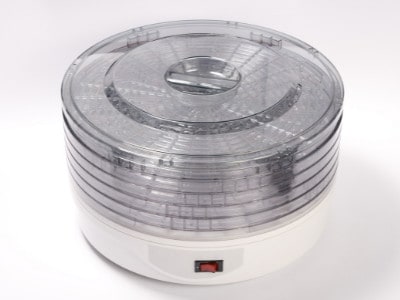
Food dehydrators with a horizontal flow are also known as shelf dehydrators.
They work similarly to a normal oven, with a heating source located at the back of the appliance.
They are more expensive than stackable food dehydrators, but they give more consistent heating.
If you want to make beef jerky, a shelf food dehydrator is the best option.
Food dehydrators with a horizontal flow are stress-free.
The heat source and the fan are positioned on the appliance’s backside. The trays are housed in a protective casing.
The fan distributes heated air evenly across all of the trays.
Why Are We Dehydrating Food in the First Place?
Dehydrating food is one of the simplest ways to preserve it.
Drying has been used for thousands of years to keep food fresh without refrigeration, and it is one of the quickest and cheapest ways to preserve your produce.
It can also reduce the weight of camping and hiking foods, saving both your back and your pocketbook.
Dehydrating your food significantly reduces the moisture level, allowing it to remain longer while still tasting good.
This is due to the fact that dehydrating your food reduces its moisture content by 5 to 20%.
The bacterium that causes food degradation cannot thrive within that range.
You can extend the life of your favorite foods by removing moisture from them.
What Can You Put in the Dehydrator?
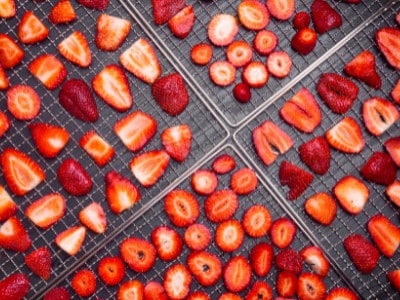
Almost any fresh meal can be dehydrated, however, some foods dehydrate better than others. Here are a few of my personal favorites.
Fruits (apples, bananas, apricots, peaches, pears, cherries, blueberries) for snacking, granola, trail mixes, or dried as purees for fruit leather.
Vegetables for soups, stews, and hiking meals (carrots, mushrooms, onions, peas, beans, tomatoes).
Meat and fish for backpacking meals or keeping for soup and stew ingredients (ground beef, chicken, or turkey; sliced meats; cured meats; fresh fish; beef jerky).
After soaking or sprouting, nuts and seeds (walnuts, hazelnuts, almonds, pecans, macadamia) become more digestible.
Sprouted grains (rice, buckwheat, barley, quinoa, amaranth) are used to preserve nutrients and store flours, granolas, and other baked goods.
Herbs for later use in teas, baking, and cooking (oregano, basil, parsley, dill, fennel, mint, lemon balm, hyssop).
Raw food diet crackers, bread, and granolas
Dehydrating Fruits and Vegetables to Extend Your Fall Harvest
Should You Invest in a Food Dehydrator?
The bottom line is…
You may be asking why you should buy a food dehydrator. Is it sufficient? Is it really worth the money?
Let’s have a look at some of the reasons why buying a food dehydrator is a good idea.
It’s a simple method for drying meat and making crispy beef jerky.
You can control your food quality in a better way
You get rid of your reliance on the local food delivery system.
It saves money that would otherwise be spent on snacks.
There is no food waste. Instead of discarding surplus homegrown veggies and fruits, you can now preserve them and enjoy them later.
Conclusion
That’s all from us, so it’s your turn!
Share your dehydrator tips with us!
You can also tell us your experience of using these gorgeous dehydrators.
We’d be waiting in the comment area!
Related Articles for You
Was this helpful?
Hi there! I’m a food enthusiast and journalist, and I have a real passion for food that goes beyond the kitchen. I love my dream job and I’m lucky enough to be able to share my knowledge with readers of several large media outlets. My specialty is writing engaging food-related content, and I take pride in being able to connect with my audience. I’m known for my creativity in the kitchen, and I’m confident that I can be the perfect guide for anyone looking to take their culinary journey to the next level.




